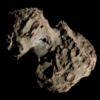astro.wikisort.org - Comet
82P/Gehrels is a periodic comet that was discovered on October 27, 1975, by Tom Gehrels at the Palomar Mountain Observatory in California having a faint nuclear brightness of magnitude 17.[1]
| Discovery | |
|---|---|
| Discovered by | Tom Gehrels |
| Discovery date | October 27, 1975 |
| Alternative designations | Gehrels 3 |
| Orbital characteristics A | |
| Epoch | 2011-Feb-08 2455600.5 |
| Aphelion | 4.6509 AU |
| Perihelion | 3.6333 AU[1] |
| Semi-major axis | 4.1421 AU |
| Eccentricity | 0.12284 |
| Orbital period | 8.43 a |
| Inclination | 1.1259° |
| Last perihelion | 2018 June 28[2][3] 2010-Jan-12[1] |
| Next perihelion | 2026-Nov-14 (JPL Horizons last obs 2020-05-20) |
Calculations based on the early sightings gave an estimated perihelion of 23 April 1975 and an orbital period of 8.11 years. It was observed by J. Gibson on its next predicted apparition in 1984, using the 122-cm Schmidt at Palomar, when he estimated the nuclear brightness at a very faint magnitude 20. It has since been observed in 1993, 2001 and 2010.[4]
The object has been identified as a quasi-Hilda comet, which means it is near a 3:2 mean-motion resonance with the planet Jupiter.[5] It fits the definition of an Encke-type comet with (TJupiter > 3; a < aJupiter).[1] It has an estimated diameter of 1.46 km.[6]
On 15 August 1970 the comet passed 0.00143 AU (214,000 km; 133,000 mi) from Jupiter.[7]
Add list
References
- "JPL Small-Body Database Browser: 82P/Gehrels 3" (2011-03-14 last obs). Jet Propulsion Laboratory. Retrieved 2012-02-18.
- Seiichi Yoshida (2011-07-03). "82P/Gehrels 3". Seiichi Yoshida's Comet Catalog. Retrieved 2012-02-18.
- Patrick Rocher (2011-03-23). "Note number : 0090 P/Gehrels 3 : 82P". Institut de mécanique céleste et de calcul des éphémérides. Retrieved 2012-02-19.
- "82P/Gehrels 3/publisher= Cometography". Archived from the original on 8 August 2009. Retrieved 24 February 2015.
- Ohtsuka, K.; Ito, T.; Yoshikawa, M.; Asher, D. J.; Arakida, H. (1 October 2008). "Quasi-Hilda comet 147P/Kushida-Muramatsu. Another long temporary satellite capture by Jupiter". Astronomy and Astrophysics. 489 (3): 1355–1362. arXiv:0808.2277. Bibcode:2008A&A...489.1355O. doi:10.1051/0004-6361:200810321. S2CID 14201751.
- Lamy, P. L.; Toth, I.; Fernandez, Y. R.; Weaver, H. A. (2004). "The sizes, shapes, albedos, and colors of cometary nuclei". In M. C. Festou; H. U. Keller; H. A. Weaver (eds.). Comets II. Bibcode:2004come.book..223L.
- "JPL Close-Approach Data: 82P/Gehrels 3" (2011-03-14 last obs). Retrieved 2012-07-28.
External links
- Orbital simulation from JPL (Java) / Horizons Ephemeris
На других языках
- [en] 82P/Gehrels
[ru] 82P/Герельса
Комета Герельса 3 (82P/Gehrels) — короткопериодическая комета типа Энке, которая была открыта 27 октября 1975 года нидерландским астрономом Томом Герельсом на фотопластинке, полученной со 122-см телескопа Паломарской обсерватории. Он описал её как слегка диффузный объект 17,0 m видимой звёздной величины с заметной конденсацией в центре. Впоследствии комету удалось обнаруживать на фотопластинках, выставленных 28 и 30 октября. Обладает довольно коротким периодом обращения вокруг Солнца — чуть более 8,43 года.Другой контент может иметь иную лицензию. Перед использованием материалов сайта WikiSort.org внимательно изучите правила лицензирования конкретных элементов наполнения сайта.
WikiSort.org - проект по пересортировке и дополнению контента Википедии

